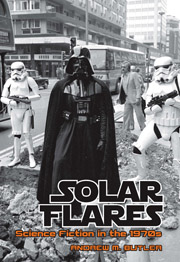Book contents
- Frontmatter
- Contents
- Acknowledgements
- Prologue
- 1 The Ends of First Sf: Pioneers as Veterans
- 2 After the New Wave: After Science Fiction?
- 3 Beyond Apollo: Space Fictions after the Moon Landing
- 4 Big Dumb Objects: Science Fiction as Self-Parody
- 5 The Rise of Fantasy: Swords and Planets
- 6 Home of the Extraterrestrial Brothers: Race and African American Science Fiction
- 7 Alien Invaders: Vietnam and the Counterculture
- 8 This Septic Isle: Post-Imperial Melancholy
- 9 Foul Contagion Spread: Ecology and Environmentalism
- 10 Female Counter-Literature: Feminism
- 11 Strange Bedfellows: Gay Liberation
- 12 Saving the Family? Children's Fiction
- 13 Eating the Audience: Blockbusters
- 14 Chariots of the Gods: Pseudoscience and Parental Fears
- 15 Towers of Babel: The Architecture of Sf
- 16 Ruptures: Metafiction and Postmodernism
- Epilogue
- Bibliography
- Index
7 - Alien Invaders: Vietnam and the Counterculture
- Frontmatter
- Contents
- Acknowledgements
- Prologue
- 1 The Ends of First Sf: Pioneers as Veterans
- 2 After the New Wave: After Science Fiction?
- 3 Beyond Apollo: Space Fictions after the Moon Landing
- 4 Big Dumb Objects: Science Fiction as Self-Parody
- 5 The Rise of Fantasy: Swords and Planets
- 6 Home of the Extraterrestrial Brothers: Race and African American Science Fiction
- 7 Alien Invaders: Vietnam and the Counterculture
- 8 This Septic Isle: Post-Imperial Melancholy
- 9 Foul Contagion Spread: Ecology and Environmentalism
- 10 Female Counter-Literature: Feminism
- 11 Strange Bedfellows: Gay Liberation
- 12 Saving the Family? Children's Fiction
- 13 Eating the Audience: Blockbusters
- 14 Chariots of the Gods: Pseudoscience and Parental Fears
- 15 Towers of Babel: The Architecture of Sf
- 16 Ruptures: Metafiction and Postmodernism
- Epilogue
- Bibliography
- Index
Summary
Grand claims have been made for the centrality of the Vietnam War to American science fiction; H. Bruce Franklin argues that ‘America's war in Indochina cannot be dissociated from American SF, which shaped and was reshaped by the nation's encounter with Vietnam’ (1990: 341). America was attempting to make the world safe for its own interests, but this just seemed to raise more doubts, both at home and abroad. Invisible enemies who supposedly threatened the American Dream on an ideological level were also to be confronted, in a series of proxy wars against communism. Vietnam was the site for one such campaign, and it was necessary to introduce a draft to supply the US armed forces. However, the supposedly technologically superior force was unable to achieve victory. In 1975, after years of street protests in America and outside American embassies, the troops made a humiliating withdrawal from the territory. Susan Sontag suggests that the media's coverage of the war did much to turn public opinion against it – not so much the television news as the newspaper photography, especially Nick Ut's famous photograph of Kim Phúc, ‘a naked South Vietnamese child just sprayed by American napalm, running down a highway toward the camera, her arms open, screaming in pain’ (1977: 18).
Alasdair Spark asserts that ‘SF certainly did not split into overt camps’ (1990: 114) over Vietnam, but perhaps the division lines had been drawn already, broadly speaking between New Waves and old guards. Kate Wilhelm and Judith Merril had been drawing up a petition against American involvement in 1968, and this sparked Poul Anderson to collect names for a petition supporting the war. Both lists were published as adverts, first in The Magazine of Fantasy and Science Fiction (March 1968) and then on facing pages in Galaxy (June 1968) (Franklin 1990: 341, 354).
- Type
- Chapter
- Information
- Solar FlaresScience Fiction in the 1970s, pp. 92 - 105Publisher: Liverpool University PressPrint publication year: 2012



